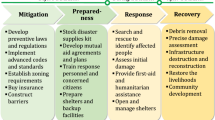Abstract
Agricultural catastrophe risk assessment is not only a practical problem which needs to be solved for the stable development of China’s agriculture under the overall background of global climate change, but also a scientific issue which urgently needs to be solved for the discipline of agricultural risk assessment. At present, the academic circle mainly studies the theories and methods of agricultural catastrophe risk assessment from different perspectives based on risk factors, risk loss as well as risk mechanism, but fails to provide a clear answer to the loss degree of agricultural production caused by extreme weather events as well as the probability distribution of agricultural catastrophe loss. In view of this problem, and on the basis of modern risk analysis and assessment theory, a basic framework for agricultural catastrophe risk assessment was constructed in this thesis, and the parallel random tree algorithm was adopted to construct an agricultural economic risk prediction model in the environment of frequent natural disasters, which could be effectively applied to agricultural economic risk prevention and control.


Similar content being viewed by others
References
Achary UR, YukiHagiwara SN, Deshpande SS, Koh JEW, Shu Lih O, Arunkumar N, Ciaccio EJ, Lim CM (2019) Characterization of focal EEG signals: a review. Futur Gener Comput Syst 91:290–299
Ambrus A, Mobius MM, Szeidl A (2007) Consumption risk-sharing in social networks[J]. Economics Working Papers 104(1):149–182
Arunkumar N, Ramkumar K, Venkatraman V, Abdulhay E, Fernandes SL, Kadry S, Segal S (2017) Classification of focal and non focal EEG using entropies. Pattern Recogn Lett 94:112–117
Ball T, Larus JR (1993) Branch prediction for free[J]. ACM SIGPLAN Not 28(6):300–313
Berry M, Bendor TK (2015) Integrating sea level rise into development suitability analysis[J]. Comput Environ Urban Syst 51(1):13–24
Brioude J, Arnold D, Stohl A et al (2013) The Lagrangian particle dispersion model FLEXPART-WRF version 3.0[J]. Geosci Model Dev 6(6):1889–1904
Bucklin RE, Sismeiro C (2003) A model of web site browsing behavior estimated on clickstream data[J]. J Mark Res 40(3):249–267
Carrère C (2006) Revisiting the effects of regional trade agreements on trade flows with proper specification of the gravity model[J]. Eur Econ Rev 50(2):223–247
Friedman BM, Laibson DI, Minsky HP (1989) Economic implications of extraordinary movements in stock prices[J]. Brook Pap Econ Act 1989(2):137–189
Gerbessiotis AV, Siniolakis CJ (1996) Deterministic sorting and randomized median finding on the BSP model[C]. In: Eighth ACM symposium on parallel algorithms and architectures. ACM, pp 223–232
Hernandez YJ, Wang J, Kearns WG et al (1999) Latent adeno-associated virus infection elicits humoral but not cell-mediated immune responses in a nonhuman primate model[J]. J Virol 73(10):8549
Jacques B, Rosenheim JA (2010) Intraguild interactions in aphid parasitoids[J]. Entomologia Experimentalis Et Applicata 97(1):93–108
Jerrett M, Finkelstein M (2005) Geographies of risk in studies linking chronic air pollution exposure to health outcomes.[J]. J Toxicol Environ Health 68(13–14):1207–1242
Kapsalis A, Raywad-Smith VJ, Smith GD (1993) Solving the graphical Steiner tree problem using genetic algorithms[J]. J Oper Res Soc 44(4):397–406
Loubergé H, Kellezi E, Gilli M (1999) Using catastrophe-linked securities to diversify insurance risk: a financial analysis of cat bonds[J]. Journal of Insurance Issues 22(2):125–146
Magnani F, Mencuccini M, Grace J (2010) Age-related decline in stand productivity: the role of structural acclimation under hydraulic constraints[J]. Plant Cell Environ 23(3):251–263
Morris DW, Kotler BP, Brown JS et al (2010) Behavioral indicators for conserving mammal diversity[J]. Ann N Y Acad Sci 1162(1):334–356
Oh SL, Hagiwara Y, Raghavendra U, Yuvaraj R, Arunkumar N, Murugappan M, Acharya UR (2018) A deep learning approach for Parkinson’s disease diagnosis from EEG signals. Neural Comput & Applic:1–7. https://doi.org/10.1007/s00521-018-3689-5
Zhou D, Al-Durra A, Gao F, Ravey A, Matraji I, Godoy Simões M (2017) Online energy management strategy of fuel cell hybrid electric vehicles based on data fusion approach. J Power Sources 366(31):278–291
Zhou D, Al-Durra A, Matraji I, Ravey A, Gao F (2018) Online energy management strategy of fuel cell hybrid electric vehicles:a fractional-order extremum seeking method. IEEE Trans Ind Electron 65(8):6787–6799
Zhou D, Al-Durra A, Zhang K, Ravey A, Gao F (2018) Online remaining useful life prediction of proton exchange membrane fuel cells using a novel robust methodology. J Power Sources 399(30):314–328
Author information
Authors and Affiliations
Corresponding author
Additional information
Publisher’s note
Springer Nature remains neutral with regard to jurisdictional claims in published maps and institutional affiliations.
Rights and permissions
About this article
Cite this article
Yong, Y., Xin, G. & Shichang, Z. Multimedia based risk forecasting model for frequent natural disasters. Multimed Tools Appl 79, 35463–35474 (2020). https://doi.org/10.1007/s11042-019-07790-z
Received:
Revised:
Accepted:
Published:
Issue Date:
DOI: https://doi.org/10.1007/s11042-019-07790-z




